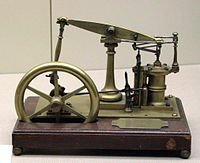
Photo from wikipedia
Abstract A small-scale experimental burner with an improved rotary valve has been designed to measure solid-propellant pressure-coupled response for mean pressures on the order of 2.2–2.9 MPa and oscillating frequencies of… Click to show full abstract
Abstract A small-scale experimental burner with an improved rotary valve has been designed to measure solid-propellant pressure-coupled response for mean pressures on the order of 2.2–2.9 MPa and oscillating frequencies of 23–161 Hz, within 9% amplitudes. This paper proposes an indirect method for measuring the instantaneous valve area and phase delay angle based on a circular grating system and a corresponding mathematical model, and the validity of which is confirmed by several cold-gas experiments and numerical simulations. The effects of frequency on oscillating pressure, exhaust mass flow rate and pressure-coupled response are studied by carrying out several hot-gas experiments and numerical simulations. The results show that the mean pressure is not affected by the oscillating frequency and maintains at 2.9 MPa. The exhaust mass flow rate of the rotary valve is determined by the instantaneous valve area and independent of frequency. The peak-to-peak pressure is inversely proportional to the oscillating frequency, reducing from 0.539 MPa at 23 Hz to 0.053 MPa at 161 Hz. The magnitude of pressure-coupled response appears to be constant (0.8) at 23–161 Hz, with pressure oscillations lagging instantaneous valve area by 0.504π-0.531π。The study is expected to benefit research on similar rotary valves and can serve as a basis for measuring the solid-propellant pressure combustion response.
Journal Title: Acta Astronautica
Year Published: 2021
Link to full text (if available)
Share on Social Media: Sign Up to like & get
recommendations!